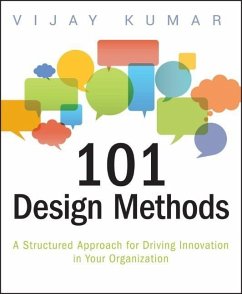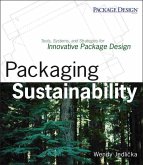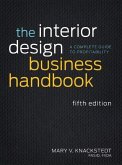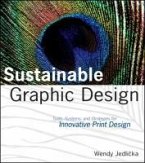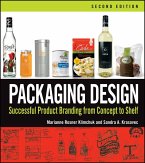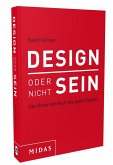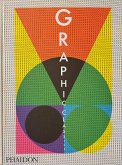28,99 €
inkl. MwSt.
Sofort lieferbar

14 °P sammeln
- Broschiertes Buch
- Merkliste
- Auf die Merkliste
- Bewerten Bewerten
- Teilen
- Produkt teilen
- Produkterinnerung
- Produkterinnerung
The first step-by-step guidebook for successful innovation planning
Unlike other books on the subject, 101 Design Methods approaches the practice of creating new products, services, and customer experiences as a science, rather than an art, providing a practical set of collaborative tools and methods for planning and defining successful new offerings. Strategists, managers, designers, and researchers who undertake the challenge of innovation, despite a lack of established procedures and a high risk of failure, will find this an invaluable resource. Novices can learn from it; managers can…mehr
Andere Kunden interessierten sich auch für
![Packaging Sustainability Packaging Sustainability]() Wendy JedlickaPackaging Sustainability42,99 €
Wendy JedlickaPackaging Sustainability42,99 €![The Interior Design Business Handbook The Interior Design Business Handbook]() Mary V. KnackstedtThe Interior Design Business Handbook109,99 €
Mary V. KnackstedtThe Interior Design Business Handbook109,99 €![Sustainable Graphic Design Sustainable Graphic Design]() Wendy JedlickaSustainable Graphic Design54,99 €
Wendy JedlickaSustainable Graphic Design54,99 €![Packaging Design Packaging Design]() Marianne R. KlimchukPackaging Design53,99 €
Marianne R. KlimchukPackaging Design53,99 €![Designing B2B Brands Designing B2B Brands]() Carlos Martinez OnaindiaDesigning B2B Brands54,99 €
Carlos Martinez OnaindiaDesigning B2B Brands54,99 €![DESIGN oder nicht SEIN DESIGN oder nicht SEIN]() David CarlsonDESIGN oder nicht SEIN14,90 €
David CarlsonDESIGN oder nicht SEIN14,90 €![Graphic Classics Graphic Classics]() Phaidon EditorsGraphic Classics61,76 €
Phaidon EditorsGraphic Classics61,76 €-
-
-
The first step-by-step guidebook for successful innovation planning
Unlike other books on the subject, 101 Design Methods approaches the practice of creating new products, services, and customer experiences as a science, rather than an art, providing a practical set of collaborative tools and methods for planning and defining successful new offerings. Strategists, managers, designers, and researchers who undertake the challenge of innovation, despite a lack of established procedures and a high risk of failure, will find this an invaluable resource. Novices can learn from it; managers can plan with it; and practitioners of innovation can improve the quality of their work by referring to it.
Hinweis: Dieser Artikel kann nur an eine deutsche Lieferadresse ausgeliefert werden.
Unlike other books on the subject, 101 Design Methods approaches the practice of creating new products, services, and customer experiences as a science, rather than an art, providing a practical set of collaborative tools and methods for planning and defining successful new offerings. Strategists, managers, designers, and researchers who undertake the challenge of innovation, despite a lack of established procedures and a high risk of failure, will find this an invaluable resource. Novices can learn from it; managers can plan with it; and practitioners of innovation can improve the quality of their work by referring to it.
Hinweis: Dieser Artikel kann nur an eine deutsche Lieferadresse ausgeliefert werden.
Produktdetails
- Produktdetails
- Verlag: Wiley & Sons
- Artikelnr. des Verlages: 1W118083460
- 1. Auflage
- Seitenzahl: 336
- Erscheinungstermin: 23. Oktober 2012
- Englisch
- Abmessung: 231mm x 192mm x 18mm
- Gewicht: 669g
- ISBN-13: 9781118083468
- ISBN-10: 1118083466
- Artikelnr.: 35450887
- Herstellerkennzeichnung
- Libri GmbH
- Europaallee 1
- 36244 Bad Hersfeld
- gpsr@libri.de
- Verlag: Wiley & Sons
- Artikelnr. des Verlages: 1W118083460
- 1. Auflage
- Seitenzahl: 336
- Erscheinungstermin: 23. Oktober 2012
- Englisch
- Abmessung: 231mm x 192mm x 18mm
- Gewicht: 669g
- ISBN-13: 9781118083468
- ISBN-10: 1118083466
- Artikelnr.: 35450887
- Herstellerkennzeichnung
- Libri GmbH
- Europaallee 1
- 36244 Bad Hersfeld
- gpsr@libri.de
VIJAY KUMAR is a professor at the IIT Institute of Design, the graduate school of design at the Illinois Institute of Technology, where he leads the Strategic Design Planning and the Design Methods programs. Kumar has taught, published, consulted, and lectured throughout the world on using structured methods, tools, and frameworks for conceiving reliable human-centered innovations and turning them into strategic plans for organizations. He has consulted for Autodesk, Motorola, Pfizer, Procter & Gamble, SC Johnson, Steelcase, Target, T-Mobile, and many others.
Foreword by James P. Hackett vii
Acknowledgments ix
Introduction 1
Four Core Principles of Successful Innovation 3
Principle 1: Build Innovations Around Experiences 3
Principle 2: Think of Innovations as Systems 5
Principle 3: Cultivate an Innovation Culture 6
Principle 4: Adopt a Disciplined Innovation Process 7
A Model of the Design Innovation Process 8
The Design Innovation Process 8
Process Is Nonlinear 9
Process Is Iterative 9
Seven Modes of the Design Innovation Process 10
Mode 1: Sense Intent 10
Mode 2: Know Context 10
Mode 3: Know People 11
Mode 4: Frame Insights 11
Mode 5: Explore Concepts 12
Mode 6: Frame Solutions 12
Mode 7: Realize Offerings 13
Understanding Methods 13
Mode 1: Sense Intent 15
Sense Intent: Mindsets 16
Sensing Changing Conditions 17
Seeing Overviews 17
Foreseeing Trends 18
Reframing Problems 18
Forming an Intent 19
Sense Intent: Methods 21
1.1 Buzz Reports 22
1.2 Popular Media Scan 24
1.3 Key Facts 26
1.4 Innovation Sourcebook 28
1.5 Trends Expert Interview 30
1.6 Keyword Bibliometrics 32
1.7 Ten Types of Innovation Framework 34
1.8 Innovation Landscape 36
1.9 Trends Matrix 38
1.10 Convergence Map 40
1.11 From...To Exploration 42
1.12 Initial Opportunity Map 44
1.13 Offering-Activity-Culture Map 46
1.14 Intent Statement 48
Mode 2: Know Context 51
Know Context: Mindsets 52
Knowing Context History 53
Understanding Frontiers 54
Seeing System Overviews 55
Understanding Stakeholders 56
Using Mental Models 57
Know Context: Methods 59
2.1 Contextual Research Plan 60
2.2 Popular Media Search 62
2.3 Publications Research 64
2.4 Eras Map 66
2.5 Innovation Evolution Map 68
2.6 Financial Profile 70
2.7 Analogous Models 72
2.8 Competitors-Complementors Map 74
2.9 Ten Types of Innovation Diagnostics 76
2.10 Industry Diagnostics 78
2.11 SWOT Analysis 80
2.12 Subject Matter Experts Interview 82
2.13 Interest Groups Discussion 84
Mode 3: Know People 87
Know People: Mindsets 88
Observing Everything 89
Building Empathy 90
Immersing in Daily Life 91
Listening Openly 92
Looking for Problems and Needs 93
Know People: Methods 95
3.1 Research Participant Map 96
3.2 Research Planning Survey 98
3.3 User Research Plan 100
3.4 Five Human Factors 102
3.5 POEMS 104
3.6 Field Visit 106
3.7 Video Ethnography 108
3.8 Ethnographic Interview 110
3.9 User Pictures Interview 112
3.10 Cultural Artifacts 114
3.11 Image Sorting 116
3.12 Experience Simulation 120
3.13 Field Activity 122
3.14 Remote Research 124
3.15 User Observations Database 126
Mode 4: Frame Insights 129
Frame Insights: Mindsets 130
Exploring Systems 131
Looking for Patterns 132
Constructing Overviews 133
Identifying Opportunities 134
Developing Guiding Principles 135
Frame Insights: Methods 137
4.1 Observations to Insights 138
4.2 Insights Sorting 140
4.3 User Observation Database Queries 142
4.4 User Response Analysis 144
4.5 ERAF Systems Diagram 146
4.6 Descriptive Value Web 150
4.7 Entities Position Map 152
4.8 Venn Diagramming 154
4.9 Tree/Semi-Lattice Diagramming 156
4.10 Symmetric Clustering Matrix 158
4.11 Asymmetric Clustering Matrix 162
4.12 Activity Network 166
4.13 Insights Clustering Matrix 170
4.14 Semantic Profile 174
4.15 User Groups Definition 176
4.16 Compelling Experience Map 178
4.17 User Journey Map 182
4.18 Summary Framework 184
4.19 Design Principles Generation 188
4.20 Analysis Workshop 190
Mode 5: Explore Concepts 195
Explore Concepts: Mindsets 196
Challenging Assumptions 197
Standing in the Future 198
Exploring Concepts at the Fringes 199
Seeking Clearly Added Value 200
Narrating Stories about the Future 201
Explore Concepts: Methods 203
5.1 Principles to Opportunities 204
5.2 Opportunity Mind Map 206
5.3 Value Hypothesis 208
5.4 Persona Definition 210
5.5 Ideation Session 212
5.6 Concept-Generating Matrix 216
5.7 Concept Metaphors and Analogies 218
5.8 Role-Play Ideation 222
5.9 Ideation Game 224
5.10 Puppet Scenario 228
5.11 Behavioral Prototype 232
5.12 Concept Prototype 234
5.13 Concept Sketch 236
5.14 Concept Scenarios 238
5.15 Concept Sorting 240
5.16 Concept Grouping Matrix 242
5.17 Concept Catalog 244
Mode 6: Frame Solutions 247
Frame Solutions: Mindsets 248
Conceiving Holistic Solutions 249
Conceiving Options 250
Making Value Judgments 251
Envisioning Scenarios 252
Structuring Solutions 253
Frame Solutions: Methods 255
6.1 Morphological Synthesis 256
6.2 Concept Evaluation 258
6.3 Prescriptive Value Web 260
6.4 Concept-Linking Map 262
6.5 Foresight Scenario 264
6.6 Solution Diagramming 266
6.7 Solution Storyboard 268
6.8 Solution Enactment 270
6.9 Solution Prototype 272
6.10 Solution Evaluation 274
6.11 Solution Roadmap 276
6.12 Solution Database 278
6.13 Synthesis Workshop 280
Mode 7: Realize Offerings 285
Realize Offerings: Mindsets 286
Reiterating Prototypes 287
Evaluating in Reality 288
Defining Strategies 289
Implementing in Reality 290
Communicating Vision 291
Realize Offerings: Methods 293
7.1 Strategy Roadmap 294
7.2 Platform Plan 296
7.3 Strategy Plan Workshop 300
7.4 Pilot Development and Testing 304
7.5 Implementation Plan 306
7.6 Competencies Plan 310
7.7 Team Formation Plan 312
7.8 Vision Statement 314
7.9 Innovation Brief 318
Credits For Example Projects 320
Index 323
Acknowledgments ix
Introduction 1
Four Core Principles of Successful Innovation 3
Principle 1: Build Innovations Around Experiences 3
Principle 2: Think of Innovations as Systems 5
Principle 3: Cultivate an Innovation Culture 6
Principle 4: Adopt a Disciplined Innovation Process 7
A Model of the Design Innovation Process 8
The Design Innovation Process 8
Process Is Nonlinear 9
Process Is Iterative 9
Seven Modes of the Design Innovation Process 10
Mode 1: Sense Intent 10
Mode 2: Know Context 10
Mode 3: Know People 11
Mode 4: Frame Insights 11
Mode 5: Explore Concepts 12
Mode 6: Frame Solutions 12
Mode 7: Realize Offerings 13
Understanding Methods 13
Mode 1: Sense Intent 15
Sense Intent: Mindsets 16
Sensing Changing Conditions 17
Seeing Overviews 17
Foreseeing Trends 18
Reframing Problems 18
Forming an Intent 19
Sense Intent: Methods 21
1.1 Buzz Reports 22
1.2 Popular Media Scan 24
1.3 Key Facts 26
1.4 Innovation Sourcebook 28
1.5 Trends Expert Interview 30
1.6 Keyword Bibliometrics 32
1.7 Ten Types of Innovation Framework 34
1.8 Innovation Landscape 36
1.9 Trends Matrix 38
1.10 Convergence Map 40
1.11 From...To Exploration 42
1.12 Initial Opportunity Map 44
1.13 Offering-Activity-Culture Map 46
1.14 Intent Statement 48
Mode 2: Know Context 51
Know Context: Mindsets 52
Knowing Context History 53
Understanding Frontiers 54
Seeing System Overviews 55
Understanding Stakeholders 56
Using Mental Models 57
Know Context: Methods 59
2.1 Contextual Research Plan 60
2.2 Popular Media Search 62
2.3 Publications Research 64
2.4 Eras Map 66
2.5 Innovation Evolution Map 68
2.6 Financial Profile 70
2.7 Analogous Models 72
2.8 Competitors-Complementors Map 74
2.9 Ten Types of Innovation Diagnostics 76
2.10 Industry Diagnostics 78
2.11 SWOT Analysis 80
2.12 Subject Matter Experts Interview 82
2.13 Interest Groups Discussion 84
Mode 3: Know People 87
Know People: Mindsets 88
Observing Everything 89
Building Empathy 90
Immersing in Daily Life 91
Listening Openly 92
Looking for Problems and Needs 93
Know People: Methods 95
3.1 Research Participant Map 96
3.2 Research Planning Survey 98
3.3 User Research Plan 100
3.4 Five Human Factors 102
3.5 POEMS 104
3.6 Field Visit 106
3.7 Video Ethnography 108
3.8 Ethnographic Interview 110
3.9 User Pictures Interview 112
3.10 Cultural Artifacts 114
3.11 Image Sorting 116
3.12 Experience Simulation 120
3.13 Field Activity 122
3.14 Remote Research 124
3.15 User Observations Database 126
Mode 4: Frame Insights 129
Frame Insights: Mindsets 130
Exploring Systems 131
Looking for Patterns 132
Constructing Overviews 133
Identifying Opportunities 134
Developing Guiding Principles 135
Frame Insights: Methods 137
4.1 Observations to Insights 138
4.2 Insights Sorting 140
4.3 User Observation Database Queries 142
4.4 User Response Analysis 144
4.5 ERAF Systems Diagram 146
4.6 Descriptive Value Web 150
4.7 Entities Position Map 152
4.8 Venn Diagramming 154
4.9 Tree/Semi-Lattice Diagramming 156
4.10 Symmetric Clustering Matrix 158
4.11 Asymmetric Clustering Matrix 162
4.12 Activity Network 166
4.13 Insights Clustering Matrix 170
4.14 Semantic Profile 174
4.15 User Groups Definition 176
4.16 Compelling Experience Map 178
4.17 User Journey Map 182
4.18 Summary Framework 184
4.19 Design Principles Generation 188
4.20 Analysis Workshop 190
Mode 5: Explore Concepts 195
Explore Concepts: Mindsets 196
Challenging Assumptions 197
Standing in the Future 198
Exploring Concepts at the Fringes 199
Seeking Clearly Added Value 200
Narrating Stories about the Future 201
Explore Concepts: Methods 203
5.1 Principles to Opportunities 204
5.2 Opportunity Mind Map 206
5.3 Value Hypothesis 208
5.4 Persona Definition 210
5.5 Ideation Session 212
5.6 Concept-Generating Matrix 216
5.7 Concept Metaphors and Analogies 218
5.8 Role-Play Ideation 222
5.9 Ideation Game 224
5.10 Puppet Scenario 228
5.11 Behavioral Prototype 232
5.12 Concept Prototype 234
5.13 Concept Sketch 236
5.14 Concept Scenarios 238
5.15 Concept Sorting 240
5.16 Concept Grouping Matrix 242
5.17 Concept Catalog 244
Mode 6: Frame Solutions 247
Frame Solutions: Mindsets 248
Conceiving Holistic Solutions 249
Conceiving Options 250
Making Value Judgments 251
Envisioning Scenarios 252
Structuring Solutions 253
Frame Solutions: Methods 255
6.1 Morphological Synthesis 256
6.2 Concept Evaluation 258
6.3 Prescriptive Value Web 260
6.4 Concept-Linking Map 262
6.5 Foresight Scenario 264
6.6 Solution Diagramming 266
6.7 Solution Storyboard 268
6.8 Solution Enactment 270
6.9 Solution Prototype 272
6.10 Solution Evaluation 274
6.11 Solution Roadmap 276
6.12 Solution Database 278
6.13 Synthesis Workshop 280
Mode 7: Realize Offerings 285
Realize Offerings: Mindsets 286
Reiterating Prototypes 287
Evaluating in Reality 288
Defining Strategies 289
Implementing in Reality 290
Communicating Vision 291
Realize Offerings: Methods 293
7.1 Strategy Roadmap 294
7.2 Platform Plan 296
7.3 Strategy Plan Workshop 300
7.4 Pilot Development and Testing 304
7.5 Implementation Plan 306
7.6 Competencies Plan 310
7.7 Team Formation Plan 312
7.8 Vision Statement 314
7.9 Innovation Brief 318
Credits For Example Projects 320
Index 323
Foreword by James P. Hackett vii
Acknowledgments ix
Introduction 1
Four Core Principles of Successful Innovation 3
Principle 1: Build Innovations Around Experiences 3
Principle 2: Think of Innovations as Systems 5
Principle 3: Cultivate an Innovation Culture 6
Principle 4: Adopt a Disciplined Innovation Process 7
A Model of the Design Innovation Process 8
The Design Innovation Process 8
Process Is Nonlinear 9
Process Is Iterative 9
Seven Modes of the Design Innovation Process 10
Mode 1: Sense Intent 10
Mode 2: Know Context 10
Mode 3: Know People 11
Mode 4: Frame Insights 11
Mode 5: Explore Concepts 12
Mode 6: Frame Solutions 12
Mode 7: Realize Offerings 13
Understanding Methods 13
Mode 1: Sense Intent 15
Sense Intent: Mindsets 16
Sensing Changing Conditions 17
Seeing Overviews 17
Foreseeing Trends 18
Reframing Problems 18
Forming an Intent 19
Sense Intent: Methods 21
1.1 Buzz Reports 22
1.2 Popular Media Scan 24
1.3 Key Facts 26
1.4 Innovation Sourcebook 28
1.5 Trends Expert Interview 30
1.6 Keyword Bibliometrics 32
1.7 Ten Types of Innovation Framework 34
1.8 Innovation Landscape 36
1.9 Trends Matrix 38
1.10 Convergence Map 40
1.11 From...To Exploration 42
1.12 Initial Opportunity Map 44
1.13 Offering-Activity-Culture Map 46
1.14 Intent Statement 48
Mode 2: Know Context 51
Know Context: Mindsets 52
Knowing Context History 53
Understanding Frontiers 54
Seeing System Overviews 55
Understanding Stakeholders 56
Using Mental Models 57
Know Context: Methods 59
2.1 Contextual Research Plan 60
2.2 Popular Media Search 62
2.3 Publications Research 64
2.4 Eras Map 66
2.5 Innovation Evolution Map 68
2.6 Financial Profile 70
2.7 Analogous Models 72
2.8 Competitors-Complementors Map 74
2.9 Ten Types of Innovation Diagnostics 76
2.10 Industry Diagnostics 78
2.11 SWOT Analysis 80
2.12 Subject Matter Experts Interview 82
2.13 Interest Groups Discussion 84
Mode 3: Know People 87
Know People: Mindsets 88
Observing Everything 89
Building Empathy 90
Immersing in Daily Life 91
Listening Openly 92
Looking for Problems and Needs 93
Know People: Methods 95
3.1 Research Participant Map 96
3.2 Research Planning Survey 98
3.3 User Research Plan 100
3.4 Five Human Factors 102
3.5 POEMS 104
3.6 Field Visit 106
3.7 Video Ethnography 108
3.8 Ethnographic Interview 110
3.9 User Pictures Interview 112
3.10 Cultural Artifacts 114
3.11 Image Sorting 116
3.12 Experience Simulation 120
3.13 Field Activity 122
3.14 Remote Research 124
3.15 User Observations Database 126
Mode 4: Frame Insights 129
Frame Insights: Mindsets 130
Exploring Systems 131
Looking for Patterns 132
Constructing Overviews 133
Identifying Opportunities 134
Developing Guiding Principles 135
Frame Insights: Methods 137
4.1 Observations to Insights 138
4.2 Insights Sorting 140
4.3 User Observation Database Queries 142
4.4 User Response Analysis 144
4.5 ERAF Systems Diagram 146
4.6 Descriptive Value Web 150
4.7 Entities Position Map 152
4.8 Venn Diagramming 154
4.9 Tree/Semi-Lattice Diagramming 156
4.10 Symmetric Clustering Matrix 158
4.11 Asymmetric Clustering Matrix 162
4.12 Activity Network 166
4.13 Insights Clustering Matrix 170
4.14 Semantic Profile 174
4.15 User Groups Definition 176
4.16 Compelling Experience Map 178
4.17 User Journey Map 182
4.18 Summary Framework 184
4.19 Design Principles Generation 188
4.20 Analysis Workshop 190
Mode 5: Explore Concepts 195
Explore Concepts: Mindsets 196
Challenging Assumptions 197
Standing in the Future 198
Exploring Concepts at the Fringes 199
Seeking Clearly Added Value 200
Narrating Stories about the Future 201
Explore Concepts: Methods 203
5.1 Principles to Opportunities 204
5.2 Opportunity Mind Map 206
5.3 Value Hypothesis 208
5.4 Persona Definition 210
5.5 Ideation Session 212
5.6 Concept-Generating Matrix 216
5.7 Concept Metaphors and Analogies 218
5.8 Role-Play Ideation 222
5.9 Ideation Game 224
5.10 Puppet Scenario 228
5.11 Behavioral Prototype 232
5.12 Concept Prototype 234
5.13 Concept Sketch 236
5.14 Concept Scenarios 238
5.15 Concept Sorting 240
5.16 Concept Grouping Matrix 242
5.17 Concept Catalog 244
Mode 6: Frame Solutions 247
Frame Solutions: Mindsets 248
Conceiving Holistic Solutions 249
Conceiving Options 250
Making Value Judgments 251
Envisioning Scenarios 252
Structuring Solutions 253
Frame Solutions: Methods 255
6.1 Morphological Synthesis 256
6.2 Concept Evaluation 258
6.3 Prescriptive Value Web 260
6.4 Concept-Linking Map 262
6.5 Foresight Scenario 264
6.6 Solution Diagramming 266
6.7 Solution Storyboard 268
6.8 Solution Enactment 270
6.9 Solution Prototype 272
6.10 Solution Evaluation 274
6.11 Solution Roadmap 276
6.12 Solution Database 278
6.13 Synthesis Workshop 280
Mode 7: Realize Offerings 285
Realize Offerings: Mindsets 286
Reiterating Prototypes 287
Evaluating in Reality 288
Defining Strategies 289
Implementing in Reality 290
Communicating Vision 291
Realize Offerings: Methods 293
7.1 Strategy Roadmap 294
7.2 Platform Plan 296
7.3 Strategy Plan Workshop 300
7.4 Pilot Development and Testing 304
7.5 Implementation Plan 306
7.6 Competencies Plan 310
7.7 Team Formation Plan 312
7.8 Vision Statement 314
7.9 Innovation Brief 318
Credits For Example Projects 320
Index 323
Acknowledgments ix
Introduction 1
Four Core Principles of Successful Innovation 3
Principle 1: Build Innovations Around Experiences 3
Principle 2: Think of Innovations as Systems 5
Principle 3: Cultivate an Innovation Culture 6
Principle 4: Adopt a Disciplined Innovation Process 7
A Model of the Design Innovation Process 8
The Design Innovation Process 8
Process Is Nonlinear 9
Process Is Iterative 9
Seven Modes of the Design Innovation Process 10
Mode 1: Sense Intent 10
Mode 2: Know Context 10
Mode 3: Know People 11
Mode 4: Frame Insights 11
Mode 5: Explore Concepts 12
Mode 6: Frame Solutions 12
Mode 7: Realize Offerings 13
Understanding Methods 13
Mode 1: Sense Intent 15
Sense Intent: Mindsets 16
Sensing Changing Conditions 17
Seeing Overviews 17
Foreseeing Trends 18
Reframing Problems 18
Forming an Intent 19
Sense Intent: Methods 21
1.1 Buzz Reports 22
1.2 Popular Media Scan 24
1.3 Key Facts 26
1.4 Innovation Sourcebook 28
1.5 Trends Expert Interview 30
1.6 Keyword Bibliometrics 32
1.7 Ten Types of Innovation Framework 34
1.8 Innovation Landscape 36
1.9 Trends Matrix 38
1.10 Convergence Map 40
1.11 From...To Exploration 42
1.12 Initial Opportunity Map 44
1.13 Offering-Activity-Culture Map 46
1.14 Intent Statement 48
Mode 2: Know Context 51
Know Context: Mindsets 52
Knowing Context History 53
Understanding Frontiers 54
Seeing System Overviews 55
Understanding Stakeholders 56
Using Mental Models 57
Know Context: Methods 59
2.1 Contextual Research Plan 60
2.2 Popular Media Search 62
2.3 Publications Research 64
2.4 Eras Map 66
2.5 Innovation Evolution Map 68
2.6 Financial Profile 70
2.7 Analogous Models 72
2.8 Competitors-Complementors Map 74
2.9 Ten Types of Innovation Diagnostics 76
2.10 Industry Diagnostics 78
2.11 SWOT Analysis 80
2.12 Subject Matter Experts Interview 82
2.13 Interest Groups Discussion 84
Mode 3: Know People 87
Know People: Mindsets 88
Observing Everything 89
Building Empathy 90
Immersing in Daily Life 91
Listening Openly 92
Looking for Problems and Needs 93
Know People: Methods 95
3.1 Research Participant Map 96
3.2 Research Planning Survey 98
3.3 User Research Plan 100
3.4 Five Human Factors 102
3.5 POEMS 104
3.6 Field Visit 106
3.7 Video Ethnography 108
3.8 Ethnographic Interview 110
3.9 User Pictures Interview 112
3.10 Cultural Artifacts 114
3.11 Image Sorting 116
3.12 Experience Simulation 120
3.13 Field Activity 122
3.14 Remote Research 124
3.15 User Observations Database 126
Mode 4: Frame Insights 129
Frame Insights: Mindsets 130
Exploring Systems 131
Looking for Patterns 132
Constructing Overviews 133
Identifying Opportunities 134
Developing Guiding Principles 135
Frame Insights: Methods 137
4.1 Observations to Insights 138
4.2 Insights Sorting 140
4.3 User Observation Database Queries 142
4.4 User Response Analysis 144
4.5 ERAF Systems Diagram 146
4.6 Descriptive Value Web 150
4.7 Entities Position Map 152
4.8 Venn Diagramming 154
4.9 Tree/Semi-Lattice Diagramming 156
4.10 Symmetric Clustering Matrix 158
4.11 Asymmetric Clustering Matrix 162
4.12 Activity Network 166
4.13 Insights Clustering Matrix 170
4.14 Semantic Profile 174
4.15 User Groups Definition 176
4.16 Compelling Experience Map 178
4.17 User Journey Map 182
4.18 Summary Framework 184
4.19 Design Principles Generation 188
4.20 Analysis Workshop 190
Mode 5: Explore Concepts 195
Explore Concepts: Mindsets 196
Challenging Assumptions 197
Standing in the Future 198
Exploring Concepts at the Fringes 199
Seeking Clearly Added Value 200
Narrating Stories about the Future 201
Explore Concepts: Methods 203
5.1 Principles to Opportunities 204
5.2 Opportunity Mind Map 206
5.3 Value Hypothesis 208
5.4 Persona Definition 210
5.5 Ideation Session 212
5.6 Concept-Generating Matrix 216
5.7 Concept Metaphors and Analogies 218
5.8 Role-Play Ideation 222
5.9 Ideation Game 224
5.10 Puppet Scenario 228
5.11 Behavioral Prototype 232
5.12 Concept Prototype 234
5.13 Concept Sketch 236
5.14 Concept Scenarios 238
5.15 Concept Sorting 240
5.16 Concept Grouping Matrix 242
5.17 Concept Catalog 244
Mode 6: Frame Solutions 247
Frame Solutions: Mindsets 248
Conceiving Holistic Solutions 249
Conceiving Options 250
Making Value Judgments 251
Envisioning Scenarios 252
Structuring Solutions 253
Frame Solutions: Methods 255
6.1 Morphological Synthesis 256
6.2 Concept Evaluation 258
6.3 Prescriptive Value Web 260
6.4 Concept-Linking Map 262
6.5 Foresight Scenario 264
6.6 Solution Diagramming 266
6.7 Solution Storyboard 268
6.8 Solution Enactment 270
6.9 Solution Prototype 272
6.10 Solution Evaluation 274
6.11 Solution Roadmap 276
6.12 Solution Database 278
6.13 Synthesis Workshop 280
Mode 7: Realize Offerings 285
Realize Offerings: Mindsets 286
Reiterating Prototypes 287
Evaluating in Reality 288
Defining Strategies 289
Implementing in Reality 290
Communicating Vision 291
Realize Offerings: Methods 293
7.1 Strategy Roadmap 294
7.2 Platform Plan 296
7.3 Strategy Plan Workshop 300
7.4 Pilot Development and Testing 304
7.5 Implementation Plan 306
7.6 Competencies Plan 310
7.7 Team Formation Plan 312
7.8 Vision Statement 314
7.9 Innovation Brief 318
Credits For Example Projects 320
Index 323
